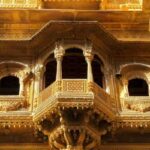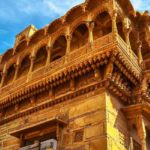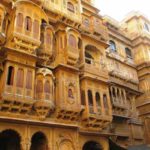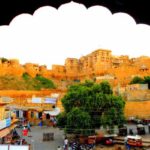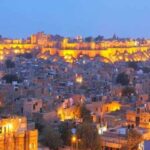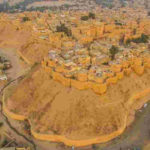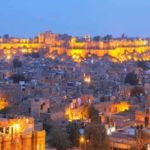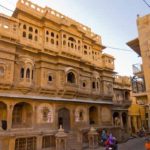Top 20 Tourist Attractions in Jaisalmer, a jewel in the heart of the Thar Desert, beckons travelers with its enchanting blend of history, architecture, and natural beauty. At the forefront of its attractions stands the magnificent Jaisalmer Fort, a golden sandstone marvel that rises majestically above the city. Its intricate architecture and panoramic views make it a must-visit destination.
The city’s Havelis, or traditional mansions, are architectural gems in their own right. Patwon Ki Haveli, a cluster of five grand havelis, showcases intricate carvings and historical significance. Salim Singh Ki Haveli’s peacock-inspired design and Nathmal Ki Haveli’s fusion of Indian and Islamic styles are equally captivating.
For a desert experience, Sam Sand Dunes provide a serene escape with camel rides, cultural performances, and awe-inspiring sunsets. The tranquil Gadisar Lake, surrounded by temples and ghats, offers boat rides and relaxation Jaisalmer Tourism.
Delve into the past at Bada Bagh, a complex of chhatris paying homage to the city’s royal legacy. The abandoned village of Kuldhara intrigues with its mysterious history and eerie ambiance. Amar Sagar Lake, with its palace and temples, provides a soothing retreat.
Jaisalmer’s Jain Temples boast intricate carvings that reflect the region’s rich artistic heritage. Tazia Tower’s multi-tiered elegance and Desert Cultural Centre’s insights into Thar Desert life are also worth exploring.
From Surya Gate’s ornate entrance to the vibrant Manak Chowk marketplace, Jaisalmer offers a cultural feast. The Silk Route Art Gallery showcases contemporary creations by local artists, while the Folklore Museum preserves traditional artifacts Jaisalmer Tour Packages.
Pay respects at the Vyas Chhatri memorial and learn about military history at the Jaisalmer War Museum. These attractions encapsulate the essence of Jaisalmer, where history, art, and desert landscapes weave together to create an unforgettable experience.
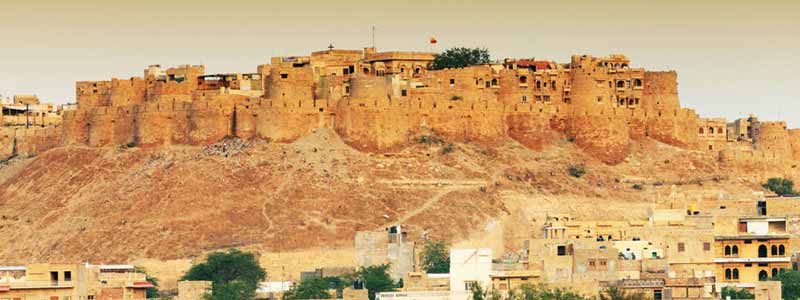
Jaisalmer Fort
Jaisalmer Fort, often referred to as the “Golden Fort” or “Sonar Quila,” is an iconic landmark that defines the city of Jaisalmer in Rajasthan, India. This UNESCO World Heritage Site stands as a testament to the city’s rich history and architectural grandeur.
The fort is renowned for its distinct honey-golden hue, a result of its construction using locally sourced yellow sandstone. Its commanding position atop Trikuta Hill provides panoramic views of the surrounding desert landscape. The fort’s walls, with their intricate carvings and detailed craftsmanship, narrate tales of bygone eras.
Built in 1156 AD by Rao Jaisal, the founder of Jaisalmer, the fort has stood the test of time and remains one of the largest fully preserved fortified cities in the world. The complex houses a thriving community within its walls, with homes, shops, temples, and havelis (traditional mansions) still in use today.
Visitors to the fort can explore its narrow alleyways, vibrant bazaars, and numerous historical sites. Notable attractions within the fort include Jain temples adorned with finely detailed sculptures, Raj Mahal with its ornate architecture, and Laxminath Temple dedicated to Lord Vishnu and Goddess Lakshmi.
Jaisalmer Fort’s intricate architecture reflects a blend of Rajput and Islamic styles, showcasing a rich cultural amalgamation. The fort’s unique design also offers natural cooling systems, a testament to the ingenuity of the builders in adapting to the harsh desert environment Jaisalmer Safari.
Over the years, Jaisalmer Fort has become a hub for tourism, attracting visitors from around the world. However, its popularity has also led to concerns about conservation and sustainable tourism practices to preserve its historical and cultural significance for future generations.
Jaisalmer Fort is not just a historic monument; it’s a living heritage that continues to inspire awe and admiration, inviting travelers to step back in time and immerse themselves in the captivating history of Rajasthan.
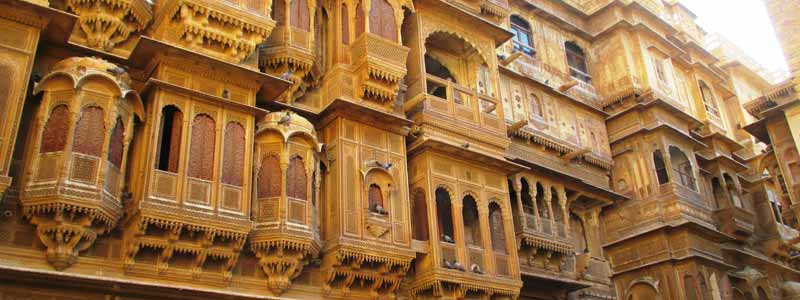
Patwon Ki Haveli
Patwon Ki Haveli stands as an epitome of architectural brilliance in the heart of Jaisalmer, Rajasthan. Comprising a cluster of five intricately designed havelis, this historical gem offers a captivating journey into the opulent past of the region.
Built in the 19th century by Guman Chand Patwa, a wealthy merchant, and his five sons, the havelis are a testament to the family’s affluence and artistic sensibilities. Each of the five havelis boasts its unique identity, seamlessly blending Rajasthani and Islamic architectural styles.
The façades of Patwon Ki Haveli are a mesmerizing canvas of intricate carvings, showcasing a medley of motifs. Delicate filigree work, ornate balconies, and exquisite jharokhas grace the sandstone exteriors. These carvings not only serve as decorative elements but also tell stories of the family’s history and the era’s cultural nuances.
Beyond their visual allure, the havelis offer a glimpse into the life of prosperous merchants during the heyday of the Silk Route trade. The interiors are adorned with intricate frescoes that depict scenes from daily life, folklore, and mythology. The meticulous detailing reflects the craftsmanship of a bygone era.
Visiting Patwon Ki Haveli is a journey through time. Exploring the narrow corridors, ascending to the upper floors, and standing on the ornate balconies evoke a sense of wonder at the intricacy and finesse of the work. The havelis’ architecture also serves as a testament to the builders’ adaptability to the harsh desert environment, creating functional and beautiful spaces.
Patwon Ki Haveli is not just a historic structure; it is a living museum that offers a tangible link to Jaisalmer’s rich past. Its enduring charm continues to draw visitors from around the world, allowing them to immerse themselves in the architectural brilliance and cultural heritage of Rajasthan.
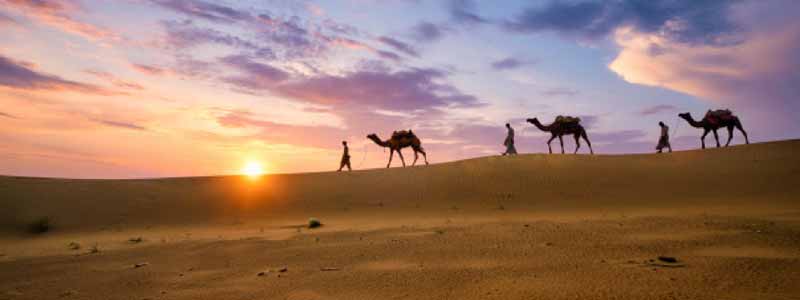
Sam Sand Dunes
Sam Sand Dunes, a captivating desert landscape near Jaisalmer in Rajasthan, India, encapsulate the mystique and allure of the Thar Desert. These towering sand dunes stand as a testament to the raw beauty and harsh splendor of desert terrain.
Located a short distance from Jaisalmer, Sam Sand Dunes offer an authentic desert experience that beckons travelers with the promise of adventure and enchantment. The dunes rise dramatically against the horizon, their golden hues transforming with the shifting light of the sun.
One of the most popular activities here is embarking on a camel safari. Riding atop these gentle desert giants, visitors traverse the undulating dunes and immerse themselves in the desert’s vastness. The rhythmic sway of the camel’s gait, the soft rustling of the sand, and the panoramic views of the surrounding landscape create an unforgettable journey.
As the sun begins its descent, the dunes become a canvas for nature’s most mesmerizing spectacle – the sunset. The desert horizon ignites with shades of orange and gold, casting long shadows across the sands. It’s a sight that words struggle to capture, a moment when time seems to stand still as the desert bids farewell to the day.
For those seeking cultural immersion, Sam Sand Dunes offer folk performances that provide insights into the region’s rich traditions. Kalbeliya dancers, musicians, and other local artists come together to present a vibrant showcase of Rajasthani culture. The lively music, graceful dance moves, and colorful attire create a lively atmosphere under the starlit desert sky.
Camping amidst the dunes is a must for travelers looking to extend their desert experience. Traditional Swiss tents or luxury camps offer a cozy and comfortable stay, allowing guests to wake up to the serene beauty of the desert at sunrise.
Sam Sand Dunes resonate with the untamed spirit of the desert, inviting travelers to explore its beauty, experience its tranquility, and immerse themselves in a world where nature’s majesty takes center stage. A visit to these dunes is an encounter with the sublime, an escape from the ordinary, and a communion with the elemental forces that have shaped this desert landscape for millennia.
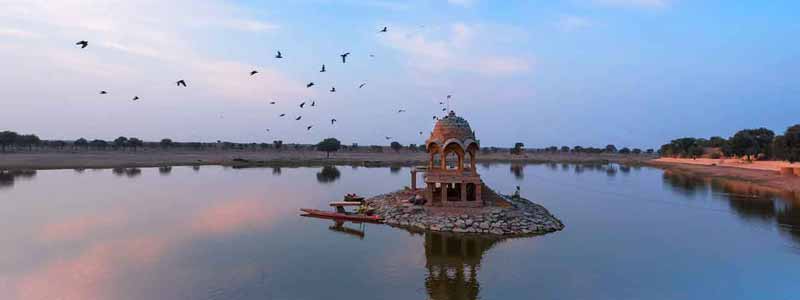
Gadisar Lake
Gadisar Lake, a serene oasis nestled in the heart of Jaisalmer, Rajasthan, India, is a tranquil haven that encapsulates the city’s history and offers a respite from the desert’s arid beauty. This historic lake, surrounded by temples, ghats, and a picturesque landscape, holds a special place in the hearts of both locals and visitors.
Constructed in the 14th century by Maharaja Gadsi Singh, the lake was initially designed to serve as a water reservoir for the city. Over time, it evolved into a cultural and recreational hub, providing water for irrigation, bathing, and religious ceremonies.
The lake’s charm is heightened by the presence of numerous shrines and ghats along its perimeter. Temples like the Tilon Ki Pol Temple and the Krishna Temple overlook the waters, creating a spiritual ambiance. The Chhatris (cenotaphs) and pavilions surrounding the lake showcase intricate architecture and provide shaded spots for reflection.
Gadisar Lake also invites visitors to embark on peaceful boat rides, offering an alternative perspective of the surroundings. As you drift across the tranquil waters, you can observe the local wildlife, including migratory birds that often grace the lake’s shores.
One of the most enchanting aspects of the lake is its association with the past. The ornate entrance arch, known as the Tilon Ki Pol, tells tales of the past through its intricately carved design. The surrounding temples and shrines offer a glimpse into the cultural and religious practices that have thrived around the lake for centuries.
Gadisar Lake’s ambiance transforms during festivals like Gangaur and Teej, when the waters come alive with beautifully adorned boats and celebratory processions. The lake becomes a focal point for these events, reflecting the vibrant traditions of Rajasthan.
In recent years, efforts have been made to preserve and rejuvenate the lake’s ecosystem. Conservation initiatives have been introduced to maintain the ecological balance and ensure the sustainability of this historical treasure.
Gadisar Lake stands as a serene testimony to the city’s history, a place where locals and tourists alike find solace in its tranquility and are reminded of the enduring connection between water and life in the heart of the desert.
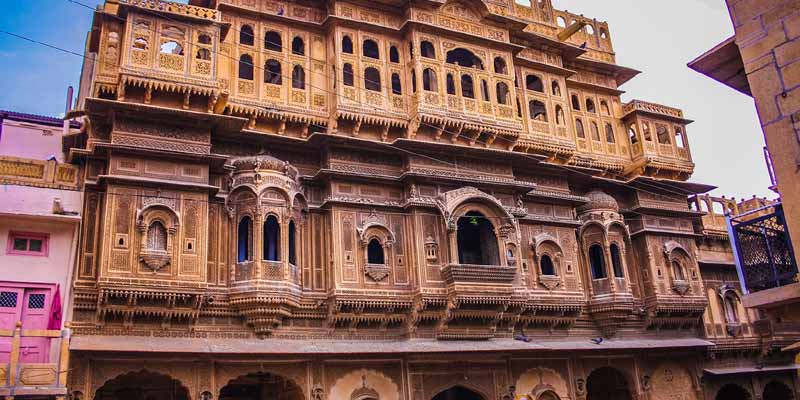
Nathmal Ki Haveli
Nathmal Ki Haveli, an architectural masterpiece nestled within the charming city of Jaisalmer in Rajasthan, India, is a testament to the creativity and craftsmanship of yesteryears. This haveli, known for its exquisite architecture and intricate designs, is a living legacy that showcases the artistic fusion of Indian and Islamic architectural styles.
Built in the 19th century by two Muslim brothers, Hathi and Lulu, who were commissioned by the then Prime Minister of Jaisalmer, Maharawal Berisal Singh, Nathmal Ki Haveli exudes a distinct charm that sets it apart from other havelis in the city. The uniqueness lies in the fact that it was constructed by two separate artisans without any prior formal training in architecture.
The haveli’s façade is a captivating canvas of intricately carved sandstone, adorned with delicate motifs that range from animals and birds to human figures and intricate lattice patterns. The symmetry in the designs is a testament to the harmonious collaboration between the two artisans.
What makes Nathmal Ki Haveli truly remarkable is the attention to detail that extends from its exterior to its interiors. The interiors are embellished with stunning wall paintings and ornate ceilings, each depicting stories from Hindu mythology, royal processions, and scenes from everyday life.
The architecture is a harmonious blend of Rajput and Islamic styles, with elements like jharokhas (overhanging windows), arches, and balconies seamlessly integrated into the design. The haveli’s two wings, constructed by the two brothers, mirror each other in terms of layout and design, yet retain subtle variations that add to its charm.
As you explore Nathmal Ki Haveli, it’s impossible not to be captivated by the finesse of its architecture and the stories it tells through its intricate carvings. The haveli stands as a tribute to the artistic heritage of Jaisalmer, offering a glimpse into the past and a reminder of the creative spirit that continues to inspire visitors and admirers from around the world.
Nathmal Ki Haveli is a living testament to the craftsmanship and artistic genius of its builders, capturing the essence of a bygone era while leaving an indelible mark on the cultural landscape of Jaisalmer.
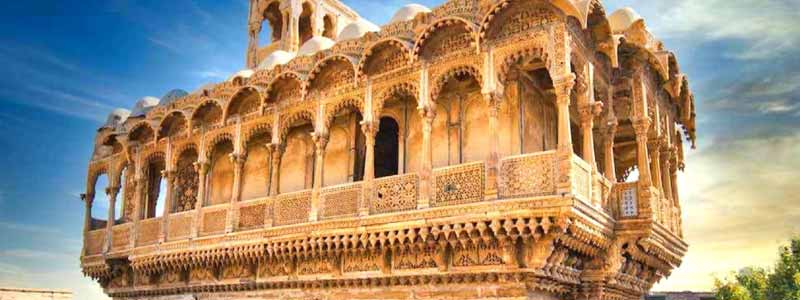
Salim Singh Ki Haveli
Salim Singh Ki Haveli, an architectural jewel nestled in the heart of Jaisalmer, Rajasthan, India, is a testament to the opulence and artistic prowess of a bygone era. This haveli, with its distinctive design and captivating façade, stands as a testament to the grandeur and sophistication of Rajasthani architecture.
Built in the 18th century by Salim Singh, the prime minister of Jaisalmer at the time, this haveli exudes an aura of regal charm. The haveli’s most iconic feature is its ornate peacock-shaped rooftop, which has become an emblem of the city’s architectural heritage. The intricate balconies and jharokhas (overhanging windows) further add to the haveli’s allure.
Salim Singh Ki Haveli’s unique architectural design is characterized by its distinctive upward-curving shape, resembling the hump of a camel. This innovative design not only showcases the builder’s creativity but also serves practical purposes by providing shade and ventilation in the desert climate.
As one steps inside the haveli, the interiors continue to astonish with their intricate carvings and exquisite craftsmanship. The haveli houses a series of rooms adorned with beautiful frescoes, intricate mirror work, and delicate stonework, reflecting the artistic sensibilities of the era.
The haveli’s opulent history is intertwined with tales of intrigue and power struggles that marked Jaisalmer’s past. The richly embellished façade and interiors offer glimpses into the luxurious lifestyle of the aristocracy, while the haveli’s grandeur serves as a reminder of the city’s prosperous trading history.
Salim Singh Ki Haveli has endured the test of time, surviving centuries and standing as a living museum of architectural marvels. As visitors explore its corridors and rooms, they are transported back in time to an era of elegance and grandeur. The haveli’s intricate design and historical significance make it a must-visit destination for those seeking to delve into the rich heritage and artistic legacy of Jaisalmer.
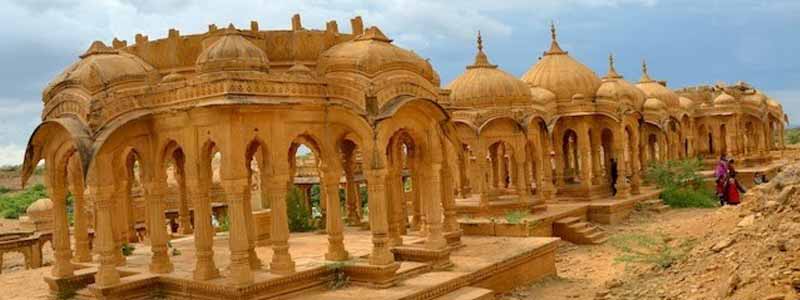
Bada Bagh
Bada Bagh, a captivating historical site located a short distance from Jaisalmer in Rajasthan, India, is a testament to the royal legacy and architectural finesse of the region. Translating to “Big Garden,” Bada Bagh is a complex of chhatris (cenotaphs) that pay homage to the Maharajas of Jaisalmer and their noble families.
Set against a backdrop of the picturesque desert landscape, Bada Bagh is a harmonious blend of art, architecture, and natural beauty. The complex is a collection of intricately designed chhatris, each dedicated to a different ruler. These chhatris, adorned with ornate carvings and elegant domes, serve as memorials to commemorate the lives of the departed royalty.
The centerpiece of Bada Bagh is the grand chhatri of Maharaja Jai Singh II, whose reign saw significant developmental contributions to the region. The imposing structure stands as a testament to his vision and accomplishments. Surrounding this central chhatri are smaller ones, each meticulously crafted with intricate details that reflect the architectural sensibilities of the time.
Beyond its architectural significance, Bada Bagh holds a deep cultural and historical relevance. The site offers a unique opportunity to connect with the history of Jaisalmer’s rulers and their contributions to the region’s development. It also provides a glimpse into the artistic craftsmanship that adorned these memorials, with their fine carvings depicting scenes of royal life, hunting, and battles.
The tranquility of Bada Bagh, coupled with its awe-inspiring architecture, makes it an ideal spot for contemplation and reflection. The site is particularly enchanting during sunrise and sunset, when the desert landscape casts a warm glow upon the chhatris, creating a magical atmosphere that transports visitors to a bygone era.
Bada Bagh stands as a testament to the enduring legacy of the Maharajas of Jaisalmer, their patronage of art and architecture, and their deep connection to the land. As visitors wander through this remarkable complex, they can’t help but be captivated by the history, culture, and beauty that converge in this historical oasis amidst the sands of Rajasthan.
Tazia Tower
Tazia Tower, an architectural marvel nestled within the charming city of Jaisalmer in Rajasthan, India, is a distinctive monument that stands as a testament to artistic fusion and cultural diversity. Rising elegantly above the city’s skyline, this multi-tiered tower captures the imagination with its unique design and intricate craftsmanship.
Constructed in the late 19th century by Muslim craftsmen, Tazia Tower is a striking example of the city’s rich architectural heritage. The tower is named after the intricate tazias, which are ornamental replicas of various mausoleums and tombs, often carried in processions during Muharram by the Shia Muslim community.
Tazia Tower’s design is a symphony of different architectural styles, reflecting the multicultural influences that have shaped Jaisalmer’s history. Each of the tower’s five levels showcases a distinct design, featuring elaborate balconies, delicate carvings, and ornamental arches that combine elements of Rajput, Mughal, and even Islamic architecture.
One of the tower’s key features is its intricate workmanship, which adorns every nook and cranny. The ornate balconies, jharokhas (overhanging windows), and chhatris (canopy-like structures) are a testament to the craftsmen’s skill and dedication to their art. The detailing extends to the façade, where floral motifs, geometric patterns, and figurative carvings intertwine seamlessly.
Tazia Tower holds cultural significance not only for its architectural prowess but also for its association with religious festivals. During Muharram, the tower’s tazias play a central role in processions that commemorate the martyrdom of Imam Husayn, the grandson of the Prophet Muhammad.
Visitors to Tazia Tower are treated to more than just a visual spectacle; they’re invited to witness the harmonious coexistence of different architectural influences and cultural practices. The tower’s towering presence against the desert backdrop offers a moment of reflection on the rich history and vibrant traditions that define Jaisalmer.
Tazia Tower’s allure lies in its ability to transport visitors to a world where architectural styles blend, cultural practices converge, and craftsmanship stands as a testament to the artistic ingenuity of Jaisalmer’s past. As the tower stands tall, it continues to embody the city’s cultural diversity and artistic legacy, leaving an indelible mark on those who are fortunate enough to behold its magnificence.
Mandir Palace
Mandir Palace, a regal masterpiece situated within the historic city of Jaisalmer in Rajasthan, India, is a living testament to the opulence and grandeur of the region’s royal past. This exquisite palace, also known as Badal Mahal, captivates visitors with its stunning architecture, intricate designs, and rich historical significance.
Built in the 19th century by Maharawal Jawahir Singh, Mandir Palace is a fusion of Rajput and Mughal architectural styles. The palace’s name, “Mandir,” which means temple, reflects the intricate carvings and ornate features that adorn its façade, reminiscent of the intricate detailing often found in temples.
The palace’s ornamental façade is a sight to behold, featuring delicate stone carvings, intricately latticed windows, and balconies adorned with artistic motifs. The craftsmanship is a testament to the skilled artisans of the time who painstakingly created a symphony of designs that reflect the regal tastes of the Rajput rulers.
Mandir Palace’s interior is equally captivating, housing a museum that showcases a diverse collection of artifacts from Jaisalmer’s royal history. Visitors can explore the opulent suites, which have been preserved to offer a glimpse into the lifestyle of the Maharawals. The collection includes royal costumes, artifacts, arms, and items of historical importance, providing a comprehensive view of the palace’s legacy.
One of the most iconic features of Mandir Palace is the Badal Vilas, a suite designed with celestial themes that reflect the beauty of clouds and rain. This suite offers a mesmerizing fusion of colors, textures, and designs, creating an ethereal ambiance that transports visitors to a world of whimsical beauty.
Mandir Palace also boasts an exquisite Durbar Hall, a regal space where grand events and ceremonies were held. The hall’s architecture and intricate details serve as a reminder of the splendor and majesty of the royal court.
As visitors explore Mandir Palace, they are not merely stepping into a grand structure; they are immersing themselves in the rich heritage and legacy of Jaisalmer’s royalty. The palace stands as a testimony to the city’s regal history, architectural brilliance, and cultural heritage, inviting travelers to journey back in time and experience the grandeur of Rajasthan’s past.
Kuldhara
Kuldhara, an enigmatic village located on the outskirts of Jaisalmer in Rajasthan, India, holds within its abandoned walls a tale of mystery and intrigue that has captured the imagination of travelers and historians alike. This ghost village, shrouded in legends and folklore, offers a glimpse into a past that is both haunting and fascinating.
The story of Kuldhara dates back to the 18th century when it was inhabited by the Paliwal Brahmins, a once-thriving community known for their agricultural prowess. According to local lore, the village was abandoned overnight, with its residents disappearing mysteriously, leaving behind empty houses and a sense of abandonment.
Legends vary regarding the reasons behind the sudden exodus. One prevalent narrative suggests that a tyrannical minister imposed heavy taxes and demanded the hand of a Paliwal Brahmin girl against her will. In response, the villagers collectively left to escape oppression and to protect their honor.
Walking through the eerily deserted streets of Kuldhara, visitors are met with an atmosphere that is haunting yet captivating. The village’s crumbling structures, decaying homes, and empty lanes evoke a sense of time standing still. Despite its abandonment, the village exudes an aura of silent resilience, a reminder of the community that once thrived there.
Kuldhara’s enigmatic charm has attracted not only history enthusiasts but also those with a penchant for the supernatural. The village’s ghostly reputation has led to its inclusion in various paranormal tales, making it a popular destination for those seeking to explore its alleged haunted aspects.
Efforts have been made to preserve Kuldhara’s historical and cultural significance, with the site being declared a protected heritage area. While the village’s past remains shrouded in mystery, its enduring allure lies in its ability to spark curiosity and imagination, inviting visitors to contemplate the stories that its walls hold.
Kuldhara stands as a silent witness to the passage of time, a place where history and legends intertwine to create a landscape that is both haunting and poignant. It’s a reminder that within the remnants of abandoned homes lies a tale that continues to intrigue and captivate those who venture to its deserted streets.
Amar Sagar Lake
Amar Sagar Lake, a serene oasis nestled near Jaisalmer in Rajasthan, India, is a tranquil haven that enchants visitors with its peaceful ambiance and historical significance. This picturesque lake, surrounded by ornate architecture and a lush landscape, offers a soothing escape from the desert’s arid beauty.
Amar Sagar Lake was commissioned by Maharawal Akhai Singh in the 17th century, and its creation is attributed to his desire to provide water and respite to travelers and locals alike. The lake’s placid waters mirror the surrounding structures, creating a scene of ethereal beauty that reflects the vibrant hues of the sky and the nearby architecture.
What adds to the charm of Amar Sagar Lake is the exquisite architecture that lines its shores. The intricate Jain temples, chhatris (cenotaphs), and the splendid Amar Singh Palace contribute to the historical and cultural richness of the area. The chhatris, in particular, are ornate memorials dedicated to the rulers of the region, showcasing intricate carvings and unique architectural elements.
The serene ambiance of Amar Sagar Lake makes it a favored destination for relaxation and reflection. Visitors can take leisurely strolls along the lake’s edge, appreciating the tranquility and the harmonious coexistence of nature and architecture.
Amar Sagar Lake also holds cultural significance, as it hosts vibrant local festivals and events. During festivals like Gangaur and Teej, the lake’s surroundings come alive with colorful celebrations, processions, and cultural performances that reflect the vibrancy of Rajasthan’s traditions.
The lake’s ecosystem and surroundings have been carefully conserved to maintain their natural beauty, making Amar Sagar Lake a place of respite for both locals and tourists seeking a moment of serenity amidst the hustle and bustle of life.
Amar Sagar Lake stands as a living testament to the harmonious interplay of water, architecture, and nature. Its timeless beauty and cultural relevance continue to beckon travelers to its shores, inviting them to experience a place where history, tranquility, and architectural splendor come together to create a truly enchanting destination.
Jain Temples
The Jain Temples of Jaisalmer, located within the majestic Jaisalmer Fort in Rajasthan, India, are a stunning testament to the intricate artistry and spiritual devotion of the Jain community. These temples, dating back centuries, are not only architectural marvels but also hold deep cultural and religious significance.
Jaisalmer is renowned for its Jain heritage, and the Jain Temples within the fort complex are among its most cherished treasures. The temples are a cluster of seven separate shrines, each dedicated to a different Tirthankara (spiritual teacher) of the Jain faith. These temples are devoted to Lord Rishabdev, Lord Parshvanath, and Lord Shantinath, among others.
The architecture of the Jain Temples is characterized by delicate carvings, intricate filigree work, and ornate detailing. The marble and sandstone structures exude a sense of spiritual tranquility, creating an environment conducive to meditation and reflection. The temple interiors are adorned with splendid frescoes, depicting scenes from Jain mythology, and the teachings of the Tirthankaras.
One of the most captivating features of the Jain Temples is their intricate latticework, which allows filtered sunlight to create a play of shadows on the interior walls. This artistic play of light adds to the serene ambiance of the temples and enhances the visual experience for visitors.
Visiting the Jain Temples is not only an architectural delight but also a cultural immersion into the beliefs and practices of the Jain community. The temples are an active place of worship, and witnessing devotees engaged in their religious rituals offers insight into the Jain way of life.
Beyond their religious significance, the Jain Temples also stand as a repository of history, preserving the art, culture, and architectural techniques of their time. The temples have been carefully maintained and restored over the years to ensure their continued splendor.
The Jain Temples of Jaisalmer are a resplendent blend of spiritual devotion and architectural brilliance. They stand as a testament to the dedication of the Jain community to their faith and heritage while inviting visitors to experience the ethereal beauty of Rajasthan’s cultural tapestry.
Desert Cultural Centre and Museum
The Desert Cultural Centre and Museum in Jaisalmer, Rajasthan, India, is a captivating institution that offers a deep dive into the rich cultural tapestry of the Thar Desert region. Situated within the historic Jaisalmer Fort, this museum is a treasure trove of artifacts, exhibits, and insights that shed light on the unique way of life, traditions, and history of the desert communities.
The museum serves as a bridge between the past and the present, providing visitors with a comprehensive understanding of the desert’s cultural heritage. The exhibits are thoughtfully curated to showcase the daily lives, customs, and craftsmanship of the people who have thrived in this arid landscape for generations.
One of the highlights of the Desert Cultural Centre and Museum is its collection of traditional textiles, clothing, and jewelry. These artifacts not only showcase the vibrant colors and intricate designs that are an integral part of desert culture but also reveal the craftsmanship and artistic skills passed down through generations.
The museum also offers insights into traditional desert industries, including pottery, leatherwork, and metal crafting. Visitors can explore exhibits that depict the production processes and the tools used by local artisans to create intricate and functional objects.
The Desert Cultural Centre and Museum goes beyond material artifacts and delves into the intangible aspects of desert life. Exhibits on folk music, dance, and oral traditions offer a glimpse into the cultural expressions that have kept the community’s identity alive.
Perhaps the most impactful aspect of the museum is its role in preserving and promoting the cultural heritage of the desert communities. Through engaging exhibits and interactive displays, visitors have the opportunity to not only learn about the past but also understand the challenges and adaptations that shape the present and future of the desert region.
As travelers walk through the Desert Cultural Centre and Museum, they embark on a journey that celebrates the resilience, creativity, and deep-rooted connections of the desert’s inhabitants. The museum stands as a beacon of cultural pride, inviting visitors to immerse themselves in the stories, traditions, and spirit of the Thar Desert.
Vyas Chhatri
Vyas Chhatri, an architectural gem situated in the captivating city of Jaisalmer, Rajasthan, India, is a monument that pays homage to the literary and cultural heritage of the region. This stunning cenotaph, dedicated to the sage Vyas who is revered for his role in composing ancient Indian texts, stands as a testament to both artistic craftsmanship and spiritual significance.
Perched atop a hill, Vyas Chhatri offers panoramic views of the surrounding landscape, including the majestic Jaisalmer Fort and the vast expanse of the Thar Desert. The monument’s elevated location adds to its allure, creating a serene ambiance that invites contemplation and reflection.
The cenotaph’s architecture is a blend of Rajput and Mughal styles, characterized by ornate detailing, intricately carved stone pillars, and delicate jharokhas (overhanging windows). The craftsmanship reflects the artistic finesse that was characteristic of the era.
The primary attraction of Vyas Chhatri is the grand memorial dedicated to Sage Vyas, the author of the Mahabharata and numerous other revered texts in Hindu mythology. The cenotaph is adorned with elaborate carvings depicting scenes from the epic, showcasing the stories and characters that have left an indelible mark on Indian literature and spirituality.
Vyas Chhatri is not only a place of architectural beauty but also holds cultural and spiritual significance. It is often visited by locals and travelers alike who seek to pay their respects to Sage Vyas and to soak in the peaceful ambiance of the site.
The monument’s surroundings are equally captivating, with lush gardens and pathways that invite visitors to explore the area and enjoy moments of tranquility. The peaceful environment makes Vyas Chhatri an ideal spot for those seeking solace and a deeper connection with the historical and cultural heritage of the region.
Vyas Chhatri stands as a poignant blend of art, spirituality, and natural beauty. Its architecture, symbolic value, and elevated location create an enchanting experience for visitors, offering a unique vantage point to appreciate the majestic landscape while honoring the literary legacy of one of India’s revered sages.
Manak Chowk
Manak Chowk, a bustling square located at the heart of Jaisalmer, Rajasthan, India, is a vibrant hub that encapsulates the city’s essence and cultural vitality. This lively marketplace, surrounded by historical landmarks, colorful shops, and local activity, offers a sensory journey into the rhythms of daily life and the rich heritage of Jaisalmer.
As the main marketplace of the city, Manak Chowk is a kaleidoscope of sights, sounds, and scents that evoke the essence of Rajasthan. The square is flanked by charming havelis, intricately carved facades, and bustling shops that showcase the region’s traditional crafts, textiles, jewelry, and handicrafts.
One of the most iconic landmarks of Manak Chowk is the Nathmal Ki Haveli, a masterpiece of architecture adorned with ornate carvings and intricate designs. Its presence adds to the historic charm of the square and provides a glimpse into the rich heritage of the city.
Manak Chowk is also a culinary haven, offering a diverse array of local street food and traditional Rajasthani delicacies. From spicy snacks to sweet treats, the food stalls and vendors cater to the taste buds of locals and tourists alike, making it a perfect place to savor the flavors of the region.
The square is a cultural crossroads where visitors can interact with locals and immerse themselves in the daily life of Jaisalmer. The vibrancy of the marketplace is heightened during festivals and events, when traditional performances, folk music, and dances bring the square to life with color and celebration.
The bustling energy of Manak Chowk extends beyond daylight hours, as the square transforms into a lively night market. As the sun sets, the square becomes a canvas of illuminated stalls and shops, creating an enchanting ambiance that is perfect for evening strolls and shopping.
Manak Chowk is not just a marketplace; it’s a cultural rendezvous that celebrates the city’s heritage and offers an authentic experience of Rajasthan’s vibrant lifestyle. Whether it’s shopping for souvenirs, indulging in local flavors, or simply absorbing the energy of the place, visitors to Manak Chowk are in for an immersive journey through the heart of Jaisalmer.
Folklore Museum
The Folklore Museum in Jaisalmer, Rajasthan, India, is a captivating repository of the region’s cultural heritage, offering visitors a fascinating journey into the traditional art, crafts, music, and lifestyle of Rajasthan. Situated within the historic Jaisalmer Fort, this museum stands as a vibrant tribute to the rich tapestry of the desert’s folklore.
The museum’s exhibits are thoughtfully curated to showcase the multifaceted aspects of Rajasthan’s cultural legacy. From intricate textiles and vibrant costumes to folk instruments and traditional jewelry, each artifact tells a story of the people, their customs, and their artistic endeavors.
One of the highlights of the Folklore Museum is its collection of puppets and puppetry paraphernalia. Puppetry has been an integral part of Rajasthan’s cultural expression, and the museum’s puppets capture the essence of the colorful tales and performances that have entertained generations.
The museum’s focus extends beyond static exhibits. It hosts live performances that showcase Rajasthani folk music, dance, and storytelling. These performances provide visitors with a sensory experience that brings the culture to life, allowing them to immerse themselves in the rhythms and narratives that define the region.
The Folklore Museum also sheds light on the traditional crafts that have flourished in the region for centuries. Visitors can witness artisans at work, creating intricate textiles, pottery, and other crafts using techniques that have been passed down through generations.
While celebrating Rajasthan’s artistic traditions, the museum also emphasizes the importance of preserving these traditions for future generations. It serves as an educational hub, offering workshops and interactive sessions to engage visitors and foster an appreciation for the cultural heritage.
Stepping into the Folklore Museum is not just an encounter with artifacts; it’s an immersion into the soul of Rajasthan. The museum’s holistic approach to culture, art, and tradition offers visitors a profound understanding of the deep-rooted connections that define the desert’s way of life.
The Folklore Museum in Jaisalmer stands as a testament to the resilience of traditions in a rapidly changing world. It encapsulates the spirit of Rajasthan, allowing visitors to explore the stories, music, crafts, and vibrancy that have sustained the region’s cultural identity for centuries.
Silk Route Art Gallery
The Silk Route Art Gallery in Jaisalmer, Rajasthan, India, is a creative haven that showcases the artistic diversity and cultural richness of the region. Situated in the heart of the city, this gallery offers a unique platform for both local and international artists to display their creations, making it a vibrant hub of artistic expression.
The gallery’s name, “Silk Route,” pays homage to the historical trade routes that connected cultures and civilizations across Asia. In a similar spirit, the gallery serves as a modern-day bridge, bringing together artists and art enthusiasts from different corners of the world.
Visitors to the Silk Route Art Gallery are treated to a visual feast of paintings, sculptures, photographs, and various forms of contemporary and traditional art. The diverse range of works reflects the artistic vibrancy of Jaisalmer and beyond, capturing the essence of both local culture and global perspectives.
One of the gallery’s unique features is its focus on promoting sustainable art practices and supporting local artisans. The gallery frequently hosts workshops and exhibitions that highlight traditional art forms and techniques, allowing visitors to engage with artists and gain insights into their creative processes.
The Silk Route Art Gallery also functions as a cultural hub, hosting events, talks, and performances that foster a sense of community among art enthusiasts. From poetry readings to music recitals, the gallery provides a platform for artistic collaboration and interaction.
In addition to its role as a creative space, the gallery contributes to the local economy by promoting art tourism and providing a platform for emerging artists to showcase their talents. It has become a must-visit destination for travelers seeking an immersive cultural experience in Jaisalmer.
The Silk Route Art Gallery encapsulates the spirit of artistic exploration, cultural exchange, and community engagement. As visitors wander through its halls, they are invited to embark on a visual journey that transcends boundaries and showcases the universal language of creativity.
Jaisalmer War Museum
The Jaisalmer War Museum, located near the Jaisalmer Military Station in Rajasthan, India, stands as a poignant tribute to the valor and sacrifice of India’s armed forces. This museum is a solemn reminder of the country’s military history, honoring the heroes who have served and defended the nation’s sovereignty.
Established in 2015, the Jaisalmer War Museum aims to educate and inspire visitors about the sacrifices made by the armed forces, particularly during the Indo-Pak wars and other conflicts. The museum’s exhibits provide insights into the lives of soldiers, their bravery on the battlefield, and their unwavering commitment to the nation.
The museum’s architecture itself is symbolic, with its design resembling a war memorial. The central exhibit is an actual Hunter aircraft, a symbol of the Indian Air Force’s role in safeguarding the country’s borders. The museum’s outdoor display includes tanks, military vehicles, and artillery pieces that serve as a testament to the might and capabilities of India’s armed forces.
Inside the museum, visitors can explore galleries that showcase the history of various battles, including the Battle of Longewala, which was a pivotal moment in the 1971 Indo-Pak War. The galleries also pay homage to the brave soldiers who have received honors and awards for their acts of valor.
One of the most moving aspects of the Jaisalmer War Museum is its Wall of Remembrance, which lists the names of soldiers who made the ultimate sacrifice for their country. This wall stands as a solemn reminder of the human cost of warfare and a tribute to the families who have lost their loved ones in service.
The museum’s interactive displays, exhibits, and audiovisual presentations create a comprehensive and immersive experience for visitors. It not only imparts knowledge about military history but also instills a sense of gratitude and respect for the sacrifices made by soldiers.
The Jaisalmer War Museum stands as a testament to the indomitable spirit of India’s armed forces and a place of reflection on the sacrifices that ensure the nation’s safety and security. It offers an opportunity for visitors to honor the valor of soldiers, understand the complexities of military life, and pay homage to those who have dedicated their lives to protecting the country.
Mool Sagar
Mool Sagar, a serene and captivating oasis located near Jaisalmer in Rajasthan, India, is a hidden gem that offers respite and beauty in the midst of the arid Thar Desert. This verdant garden and lake complex, surrounded by lush foliage and serene waters, stands as a testament to human ingenuity and the harmonious coexistence of nature and architecture.
Built in the 18th century by Maharawal Moolraj II, Mool Sagar was envisioned as a water conservation project to address the scarcity of water in the region. The complex comprises a tranquil lake, intricate stepwells, and a meticulously designed garden that showcases the Rajput rulers’ skill in engineering and aesthetics.
The centerpiece of Mool Sagar is the picturesque lake, which acts as a reservoir for rainwater. The serene waters reflect the sky’s hues, creating a mesmerizing play of colors that adds to the garden’s enchanting beauty. The lake also serves as a haven for migratory birds, making it a paradise for birdwatchers and nature enthusiasts.
Surrounding the lake is a series of exquisitely designed stepwells, known as “baoris.” These stepwells not only provide access to the water source but also showcase intricate carvings, pavilions, and arches that are characteristic of Rajput architecture. The stepwells served as gathering places for locals and travelers, offering shelter and refreshment in the desert’s harsh climate.
The Mool Sagar garden, with its symmetrical layout, fountains, and lush greenery, creates a tranquil oasis that contrasts with the surrounding desert landscape. The garden’s design incorporates elements of Mughal and Rajput aesthetics, resulting in a harmonious blend of architectural styles.
Mool Sagar is not just a historical site; it’s a testament to human determination to harness and conserve natural resources. The complex’s functional and aesthetic elements offer visitors a glimpse into the past while inviting them to experience the peace and tranquility that this oasis provides.
As visitors wander through the garden’s pathways, listen to the gentle rustling of the leaves, and admire the architectural marvels, they are reminded of the delicate balance between nature and human intervention. Mool Sagar stands as a living legacy of water conservation and architectural brilliance, offering a serene escape in the heart of the desert.

